List of mammals of Tasmania facts for kids
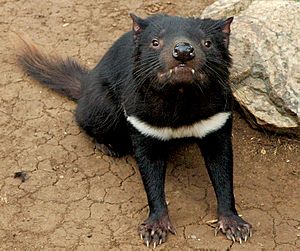
Tasmania is an island state in Australia, and it's home to many unique animals! Mammals are a big group of animals that usually have fur or hair and feed their babies milk. In Tasmania, mammals are split into three main types based on how they have their babies:
- Monotremes: These are super special mammals that lay eggs!
- Marsupials: These mammals have a pouch where their babies grow and develop after birth.
- Placental Mammals: Most mammals you know are in this group. Their babies grow inside the mother's body until they are more developed.
Let's explore some of the amazing mammals you can find in Tasmania!
Contents
Monotremes: Egg-Laying Mammals
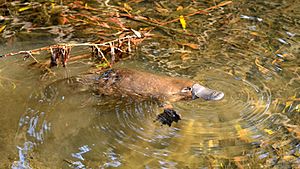
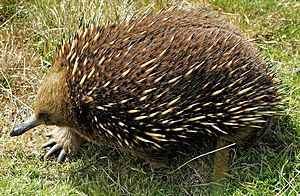
Monotremes are very rare mammals. There are only a few types left in the world, and Tasmania is lucky to have two of them! They are unique because they lay eggs, just like birds or reptiles, but they still feed their young milk.
Platypus
- Platypus, Ornithorhynchus anatinus
The platypus is a shy animal that lives in rivers and streams. It has a bill like a duck, a tail like a beaver, and webbed feet. It's one of the most unusual animals on Earth!
Echidna
- Short-beaked echidna, Tachyglossus aculeatus
The echidna is covered in sharp spines, like a porcupine. It uses its long snout and sticky tongue to catch ants and termites. When it feels scared, it can roll into a spiky ball to protect itself.
Marsupials: Pouched Mammals
Marsupials are famous for their pouches! Their babies are born very tiny and undeveloped. They then crawl into their mother's pouch, where they stay safe and drink milk until they are big enough to come out.
Marsupial Carnivores
This group includes marsupials that mostly eat meat. They are like the wild cats and dogs of the marsupial world.
Tasmanian Devil
- Tasmanian devil, Sarcophilus harrisii
The Tasmanian devil is the largest meat-eating marsupial in the world. It's known for its loud screeches, strong bite, and black fur. Tasmanian devils are found only in Tasmania, which means they are endemic to the island. They are important for keeping the environment healthy by eating dead animals.
Quolls
- Tiger quoll, Dasyurus maculatus
- Eastern quoll, Dasyurus viverrinus
Quolls are spotted, cat-like marsupials. The Tiger quoll is the largest marsupial carnivore on the Australian mainland, but it also lives in Tasmania. The Eastern quoll is also found in Tasmania and used to live on the mainland but is now mostly found only on the island.
Antechinus
- Swamp antechinus, Antechinus minimus
- Dusky antechinus, Antechinus swainsonii
These are small, mouse-like marsupials. They are very active hunters, eating insects and other small creatures.
Dunnart
- White-footed dunnart, Sminthopsis leucopus
Dunnarts are tiny marsupials, often looking like small mice. They are mostly active at night and eat insects.
Bandicoots: Digging Marsupials
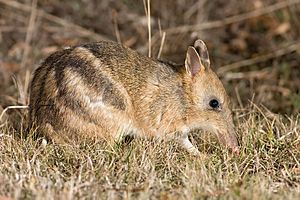
Bandicoots are small marsupials with pointed snouts and strong claws, perfect for digging. They often dig for insects, worms, and plant roots.
- Southern brown bandicoot, Isoodon obesulus
- Eastern barred bandicoot, Perameles gunnii
Wombats and Possums: Tree-Climbing and Burrowing Marsupials
This is a big group with many different kinds of marsupials, from slow-moving wombats to agile possums.
Wombats
- Common wombat, Vombatus ursinus
Wombats are strong, burrowing marsupials. They have short legs and powerful claws, which they use to dig extensive tunnels underground. They are mostly active at night and eat grasses and roots.
Possums and Gliders
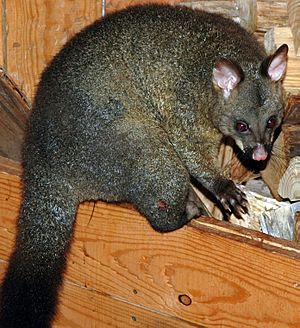
Possums are mostly tree-dwelling marsupials. They are often active at night and eat leaves, fruits, and insects.
- Common brushtail possum, Trichosurus vulpecula
This is one of the most common possums in Australia and Tasmania. It has a bushy tail and can often be seen in suburban areas.
- Tasmanian pygmy possum, Cercartetus lepidus
- Eastern pygmy possum, Cercartetus nanus
These are some of the smallest possums in the world, tiny enough to fit in your hand! They eat nectar and pollen from flowers.
- Krefft's glider, Petaurus notatus
This possum has a special flap of skin between its front and back legs, allowing it to glide from tree to tree. It was introduced to Tasmania, meaning it was brought there by people from the Australian mainland.
- Common ringtail possum, Pseudocheirus peregrinus
This possum has a long, prehensile tail that it uses to grip branches. It often builds a nest called a "dreys" in trees.
Kangaroos and Wallabies: Hopping Marsupials
This group includes the famous kangaroos and wallabies, known for their powerful hind legs and hopping movement.
Potoroo and Bettong
- Southern bettong, Bettongia gaimardi
- Long-nosed potoroo, Potorous tridactylus
These are smaller relatives of kangaroos and wallabies. They are often called "rat-kangaroos" and mostly eat fungi, roots, and insects. The Southern bettong is endemic to Tasmania.
Kangaroos and Wallabies
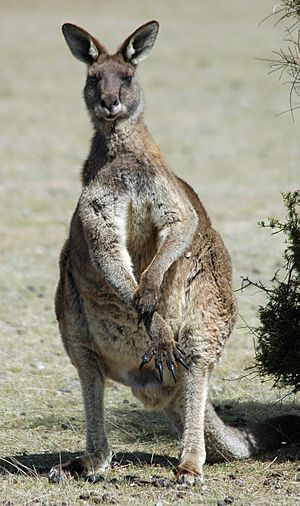
- Eastern grey kangaroo, Macropus giganteus
This is one of the largest kangaroos. They live in groups and graze on grasses.
- Red-necked wallaby, N. rufogriseus
Wallabies are smaller than kangaroos. The Red-necked wallaby is common in Tasmania and has reddish fur on its neck and shoulders.
- Tasmanian pademelon, Thylogale billardierii
Pademelons are small, shy wallabies that live in dense forests and eat plants. The Tasmanian pademelon is endemic to Tasmania.
Placental Mammals: Well-Developed Babies
Placental mammals are the most common type of mammal. Their babies grow inside the mother's body, connected by a placenta, which provides food and oxygen. This allows the babies to be born more developed.
Deer
- Common fallow deer, Dama dama
These deer were introduced to Tasmania by humans. They are now found in many parts of the island.
Seals: Ocean Hunters
Seals are marine mammals that spend most of their lives in the ocean but come to land to rest and have their pups.
- Cape fur seal, Arctocephalus pusillus
- New Zealand fur seal, Arctocephalus fosteri
- Southern elephant seal, Mirounga leonina
- Leopard seal, Hydrurga leptonyx
Bats: Flying Mammals
Bats are the only mammals that can truly fly! They use their wings, which are made of skin stretched between their fingers and body, to soar through the air. Many bats use echolocation (like sonar) to find food and navigate in the dark.
- Little forest bat, Vespadelus vulturnus
- Southern forest bat, Vespadelus regulus
- Large forest bat, Vespadelus darlingtoni
- Chocolate wattled bat, Chalinolobus morio
- Gould's wattled bat, Chalinolobus gouldii
- Lesser long-eared bat, Nyctophilus geoffroyi
- Greater long-eared bat, Nyctophilus timoriensis
- Eastern false pipistrelle, Falsistrellus tasmaniensis
Rabbits and Hares
- European rabbit, Oryctolagus cuniculus
- European hare, Lepus europaeus
These animals were introduced to Tasmania by humans and are now common.
Rodents: Rats and Mice
Rodents are a very large group of mammals known for their continuously growing front teeth.
- Rakali, Hydromys chrysogaster
Also known as the Australian water rat, this native rodent lives near water and eats fish, insects, and other small animals.
- House mouse, Mus musculus
- Black rat, Rattus rattus
- Brown rat, Rattus norvegicus
These common rodents were introduced to Tasmania by humans.
- Long-tailed mouse, Pseudomys higginsi
This native mouse is endemic to Tasmania, meaning it's found only there.
- New Holland mouse, Pseudomys novaehollandiae
- Broad-toothed mouse, Mastacomys fuscus
- Swamp rat, Rattus lutreolus
These are other native rodents found in Tasmania.
Whales and Dolphins: Ocean Giants
Whales and dolphins are marine mammals that live entirely in the ocean. They are incredibly diverse, from small dolphins to giant whales.
Toothed Whales
Toothed whales have teeth and hunt for fish, squid, and other marine animals.
- Long-finned pilot whale, Globicephala melaena
- Killer whale, Orcinus orca
- False killer whale, Pseudorca crassidens
- Short-beaked common dolphin, Delphinus delphis
- Common bottlenose dolphin, Tursiops truncatus
- Sperm whale, Physeter catodon
The sperm whale is the largest toothed predator on Earth.
Baleen Whales
Baleen whales don't have teeth. Instead, they have baleen plates in their mouths, which they use to filter tiny organisms like krill and small fish from the water.
- Southern right whale, Eubalaena australis
- Pygmy right whale, Caperea marginata
- Humpback whale, Megaptera novaeangliae
Humpback whales are famous for their long migrations and their beautiful songs.

